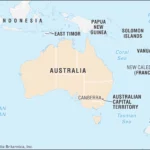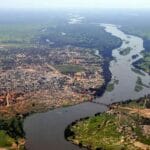Muscat, the capital of Oman, is more than just a coastal city; it’s a captivating blend of ancient history, vibrant culture, and modern development nestled between the dramatic Al Hajar Mountains and the turquoise waters of the Gulf of Oman. This article delves deep into the heart of Oman, exploring Muscat’s unique geography, rich heritage, and its dynamic present.
Muscat’s Dramatic Landscape: Where Mountains Meet the Sea
Muscat’s stunning landscape is defined by the dramatic convergence of the Al Hajar Mountains and the Arabian Sea. These mountains provide a breathtaking backdrop to the city’s whitewashed buildings and have historically played a crucial role in its defense. Muttrah, the historic port district, offers a vibrant atmosphere with picturesque views of traditional Omani dhows bobbing in the harbor. Discover the captivating beauty of other coastal regions like Kolomotu a Tonga.
A Geographical Masterpiece
The Al Hajar Mountains aren’t merely a scenic backdrop; they’ve significantly influenced settlement patterns and provided natural protection throughout Muscat’s history. This rugged terrain likely contributed to the development of distinct communities and shaped the city’s strategic importance.
Muttrah: A Window to the Past
Muttrah, the historic port, offers a sensory experience where the aroma of frankincense mingles with the salty sea air. The corniche, a bustling promenade, provides stunning views of the harbor and a glimpse into Muscat’s maritime heritage.
Muscat’s Rich Trading History: A Cultural Crossroads
Muscat’s strategic location on the Maritime Silk Road has made it a vital port for centuries. This position attracted merchants from across the globe, fostering a unique blend of cultures reflected in the city’s diverse architecture and cuisine.
A History Woven in Trade
The city’s history is deeply intertwined with maritime trade. From as early as the 1st century AD, Muscat’s harbor bustled with activity, attracting traders from Persia, India, East Africa, and beyond. This cultural exchange has undoubtedly left an indelible mark on the city’s character.
Architectural Echoes of the Past
Muscat’s architecture likely reflects its diverse history. Buildings may showcase influences from various cultures, whispering stories of past interactions and exchanges.
Muscat Today: Balancing Modernization and Heritage
Modern Muscat represents a fascinating juxtaposition of old and new. Contemporary buildings rise alongside ancient forts, while bustling traditional souks coexist with modern shopping malls. This delicate balance suggests Oman’s commitment to preserving its heritage while embracing progress. Explore Muscat’s place within Oman.
A City in Transition
Muscat is actively navigating the complexities of modernization while striving to retain its cultural identity. This ongoing process presents both challenges and opportunities for the city’s future.
Preserving the Past for the Future
Oman’s efforts to preserve its heritage likely stem from a deep understanding of its importance in a rapidly changing world. This commitment to the past may offer valuable lessons for other cities facing similar challenges.
Beyond Muscat’s City Walls: Exploring Untamed Beauty
Muscat’s territory extends beyond the urban center, encompassing breathtaking natural wonders. Pristine beaches, dramatic canyons, and hidden oases punctuate the landscape, offering opportunities for exploration and discovery.
Unveiling Hidden Gems
The diverse landscapes surrounding Muscat beckon adventurers to uncover their hidden treasures. From cascading waterfalls to rare desert flora, the possibilities for discovery are endless.
A Tapestry of Natural Wonders
The natural beauty surrounding Muscat contributes to its unique appeal. These diverse environments offer a glimpse into the ecological richness of Oman.
Muscat’s Global Significance: A Strategic Location
Muscat’s proximity to the Strait of Hormuz, a critical chokepoint for global oil transport, imbues it with immense geopolitical significance. Oman’s neutrality in regional conflicts likely contributes to the stability of this vital waterway, according to some experts.
A Linchpin in Global Trade
The Strait of Hormuz plays a crucial role in international trade and energy security. Muscat’s location near this strategic waterway highlights its importance on the world stage.
Oman’s Balancing Act
Oman’s neutral stance in regional affairs probably contributes to maintaining stability in a volatile region. This diplomatic approach may be crucial for ensuring the continued flow of global commerce.
Muscat’s People: A Mosaic of Cultures
| Year | Population | % Omani Citizens |
|---|---|---|
| 2003 | ~630,000 | 60% |
| Current | 1.72 million (2022) | Update Required |
The 2003 census, while providing a historical snapshot, requires updating to reflect Muscat’s current demographic makeup accurately. The Muscat Governorate’s population reached approximately 1.72 million in 2022, according to the National Centre for Statistics and Information (NCSI). Ongoing research seeks to understand the evolving cultural landscape and the complex interplay of cultures within this dynamic coastal city.
A Dynamic Population
Muscat’s population has grown significantly since 2003, highlighting the city’s continued development and attractiveness. This growth likely presents both opportunities and challenges for maintaining social cohesion and managing resources.
Ongoing Cultural Transformations
The influx of people from various backgrounds probably contributes to Muscat’s evolving cultural landscape. Research into these demographic shifts may provide valuable insights into the changing dynamics of the city’s identity.
What is Muscat land?
“Muscat land” encompasses more than just its geographical location where the Al Hajar Mountains meet the Gulf of Oman. It represents a rich tapestry woven with threads of history, trade, and natural beauty. Historically, “Muscat” primarily referred to the coastal areas, a vibrant center of maritime activity, while “Oman” denoted the interior. This distinction, shaped by the Al Jabal Al Akhdar mountain range, suggests a historical duality that adds depth to Oman’s present-day identity. Muscat’s strategic position on the Maritime Silk Road transformed it into a melting pot of cultures, attracting traders and travelers from across the globe.
Two Sides of the Same Coin: Muscat and Oman
The historical distinction between “Muscat” and “Oman” reflects the geographical and cultural differences between the coast and the interior. This duality eventually merged into the unified Sultanate of Oman, with Muscat as its capital.
Ancient Echoes: Archaeological Treasures
Archaeological excavations at Ras al-Hamra have unearthed remnants of early fishing communities dating back to the 6th millennium BC. These discoveries offer a glimpse into Muscat’s ancient past and the lives of its earliest inhabitants.
Muscat Today: A City of Contrasts
Modern Muscat embodies a captivating blend of old and new. Low-rise, whitewashed buildings stand in contrast to the backdrop of towering mountains, while the Muttrah souq provides a sensory immersion into traditional Omani life. The Muscat Governorate’s population of approximately 1.72 million reflects the diverse demographics of Oman. Population growth and urbanization will likely continue to shape Muscat’s future, presenting both challenges and opportunities.
From Dhows to LNG: Economic Evolution
Muscat’s economy, historically rooted in the trade of spices, textiles, and other goods, has evolved to embrace petroleum and liquefied natural gas (LNG). The port, once dominated by dhows, now accommodates massive cargo ships, symbolizing the city’s ongoing economic transformation.
What is Muscat’s country?
Muscat is the capital of the Sultanate of Oman, a country located on the southeastern coast of the Arabian Peninsula. The historical distinction between “Muscat” (coastal region) and “Oman” (interior) eventually merged into the unified nation we know today. Muscat’s strategic location on the Maritime Silk Road facilitated trade and cultural exchange with civilizations across the globe. Archaeological findings at Ras al-Hamra reveal settlements dating back to the 6th millennium BC, highlighting the region’s ancient roots. Modern Muscat is a dynamic blend of tradition and modernity, facing the ongoing challenge of balancing economic development with cultural preservation.
| Aspect of Muscat’s Land | Description | Significance |
|---|---|---|
| Coastal Location | Situated on the Gulf of Oman | Facilitated maritime trade and cultural exchange |
| Al Hajar Mountains | Natural barrier separating coast from interior | Historically divided Muscat and Oman regions |
| Ras al-Hamra | Site of ancient burial grounds | Evidence of early settlements dating back millennia |
| Muttrah Port | Historic harbor | Connects past and present, showcasing traditional and modern maritime activity |
Our understanding of Muscat’s history continues to evolve as research progresses and new discoveries are made. Ongoing studies may further illuminate the complex factors that have shaped this fascinating city.
Which country capital is Muscat?
Muscat is the capital of Oman, a country on the southeastern coast of the Arabian Peninsula. It is Oman’s largest city, its main port, and a vibrant center of commerce and culture. Muscat’s strategic location on the historic Maritime Silk Road has shaped its identity for millennia, influencing its architecture, cuisine, and diverse population. Archaeological evidence suggests settlements dating back to the 6th millennium BC, pointing to a long and rich history. Modern Muscat exhibits a striking blend of ancient and contemporary elements, balancing rapid development with the preservation of its unique Omani heritage. While the city’s economy has diversified, the legacy of maritime trade remains a powerful influence. Some scholars believe that Muscat’s growth may have been influenced by periods of regional instability, while ongoing research explores the potential impact of climate change on its coastal areas. Muscat is a dynamic city in constant evolution, a true jewel of the Arabian Peninsula.
- Guatemala vs. Costa Rica: Plan Your Trip Smartly - April 16, 2025
- Master Types of Pumps: Ultimate Guide to Selection - April 16, 2025
- Unlock Types of Makeup Secrets: Master Any Look Now - April 16, 2025
















1 thought on “Unveiling the Secrets of Muscat’s Land: A Journey Through Oman’s Coastal Gem”
Comments are closed.